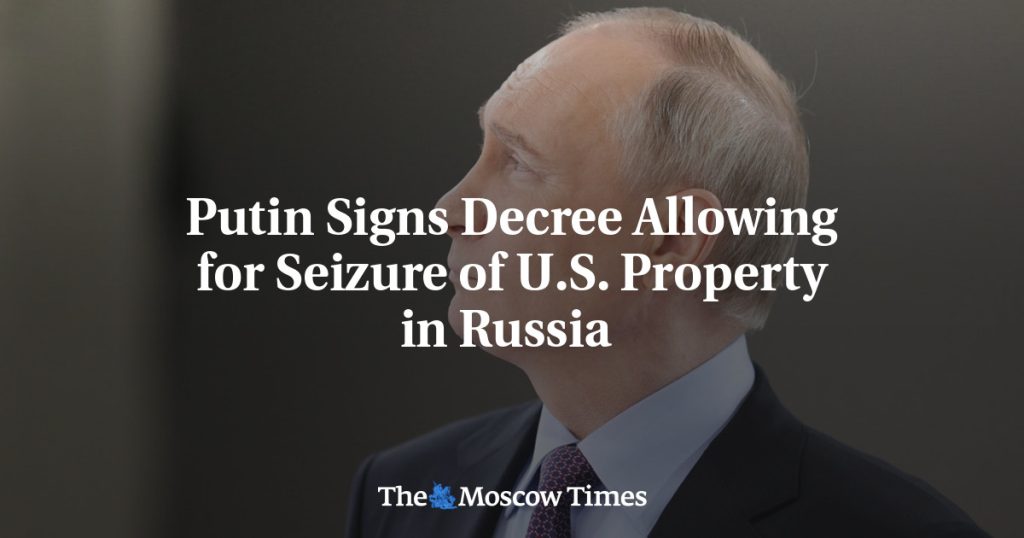President Vladimir Putin recently signed a decree that allows Moscow to take control of U.S. property as compensation for any seizure of frozen Russian assets in the United States. Following the full-scale invasion of Ukraine, Washington and its European allies seized or blocked around $300 billion of Russian financial assets. In response to these punitive measures, Moscow detained the assets of many foreign investors in special accounts that cannot be transferred outside of Russia without the Kremlin’s approval. The decree instructs Russia’s state commission on monitoring foreign investment to determine the types of U.S. property a Russian rights holder could seek to confiscate through the court as compensation for assets frozen in the United States. Real estate, personal property, securities, shares, and property rights were listed as potential U.S.-owned assets potentially liable for seizure, with the Russian government directed to make the necessary legal changes allowing for the U.S. property seizures by the end of September.
Moscow has previously threatened to confiscate the Russia-based assets of countries it considers to be “hostile” following the invasion of Ukraine over two years ago. Last year, Putin allowed for a temporary state takeover of the Russian divisions of the German energy giant Uniper and Finland’s Fortum in response to what he deemed as “unfriendly U.S. actions”. This recent decree comes shortly after U.S. President Joe Biden signed into law critical military aid to Ukraine, which also included provisions for Washington to sell confiscated Russian assets and hand the proceeds to Kyiv for post-war reconstruction efforts. The ongoing tensions and retaliatory measures between Russia and the United States highlight the escalating conflict and diplomatic strain between the two nations.
The decree signed by President Putin is seen as a retaliatory move in response to the actions taken by the U.S. and its allies against Russian assets after the invasion of Ukraine. By allowing for the seizure of U.S. property as compensation for frozen Russian assets, Moscow is sending a strong message of defiance and resistance against what it perceives as unjust sanctions imposed by Western powers. The potential seizure of U.S.-owned assets highlights the depth of the economic and diplomatic rift between Russia and the United States, with both sides resorting to aggressive measures to assert their respective positions.
The decision to target U.S. property for potential seizure reflects Russia’s strategy of using economic leverage as a tool for retaliation and negotiation. By threatening the confiscation of American assets, Moscow is attempting to exert pressure on Washington and its allies while also signaling its willingness to escalate the conflict if necessary. The decree instructing the state commission on monitoring foreign investment to determine the types of U.S. property eligible for confiscation underscores the seriousness of Russia’s intentions and its willingness to take bold actions in response to perceived provocations.
The ongoing tensions between Russia and the United States have far-reaching implications for global geopolitics and diplomatic relations. The tit-for-tat retaliatory measures, including the recent decree allowing for the seizure of U.S. property, demonstrate the deteriorating state of relations between the two countries. As both sides continue to engage in aggressive tactics and maneuvers, the risk of further escalation and conflict remains a significant concern. The latest developments highlight the challenges of navigating the complex and volatile landscape of international relations, where economic sanctions and diplomatic maneuvers are used as weapons in a high-stakes game of geopolitical rivalry.
In conclusion, President Putin’s decree allowing for the potential seizure of U.S. property as compensation for frozen Russian assets represents a significant escalation in the ongoing conflict between Russia and the United States. The decision to target American assets reflects Moscow’s strategy of using economic leverage to assert its position and respond to what it considers unjust actions by Western powers. As tensions between the two countries continue to rise, the risk of further escalation and conflict remains a pressing concern for global stability. The implications of these developments extend beyond the economic realm, impacting diplomatic relations and the broader geopolitical landscape. As both Russia and the United States navigate a complex and volatile relationship, the potential for further confrontations and retaliatory measures underscores the challenges of managing international relations in an increasingly polarized world.


